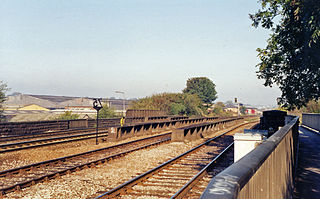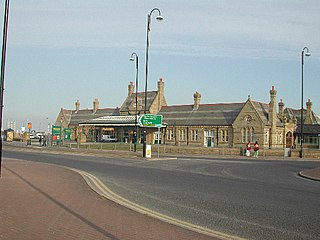Related Research Articles

The West Coast Main Line (WCML) is one of the most important railway corridors in the United Kingdom, connecting the major cities of London and Glasgow with branches to Birmingham, Liverpool, Manchester and Edinburgh. It is one of the busiest mixed-traffic railway routes in Europe, carrying a mixture of intercity rail, regional rail, commuter rail and rail freight traffic. The core route of the WCML runs from London to Glasgow for 399 miles (642 km) and was opened from 1837 to 1869. With additional lines deviating to Northampton, Birmingham, Manchester, Liverpool and Edinburgh, this totals a route mileage of 700 miles (1,127 km). The Glasgow–Edinburgh via Carstairs line connects the WCML to Edinburgh, however the main London–Edinburgh route is the East Coast Main Line. Several sections of the WCML form part of the suburban railway systems in London, Coventry, Birmingham, Liverpool, Manchester and Glasgow, with many more smaller commuter stations, as well as providing links to more rural towns.

The London and North Western Railway was a British railway company between 1846 and 1922. In the late 19th century, the L&NWR was the largest joint stock company in the United Kingdom.

The London, Midland and Scottish Railway (LMS) was a British railway company. It was formed on 1 January 1923 under the Railways Act of 1921, which required the grouping of over 120 separate railways into four. The companies merged into the LMS included the London and North Western Railway, Midland Railway, the Lancashire and Yorkshire Railway, several Scottish railway companies, and numerous other, smaller ventures.

Crewe railway station is a railway station in Crewe, Cheshire, England. It opened in 1837 and is one of the most historically significant railway stations in the world.

Watford Junction is a railway station that serves Watford, Hertfordshire. The station is on the West Coast Main Line (WCML), 17 miles 34 chains from London Euston and the Abbey Line, a branch line to St Albans. Journeys to London take between 16 and 52 minutes depending on the service used: shorter times on fast non-stop trains and slower on the stopping Watford DC line services. Trains also run to Clapham Junction and East Croydon via the West London Line. The station is a major hub for local bus services and the connecting station for buses to Warner Bros. Studio Tour London – The Making of Harry Potter. The station is located north of a viaduct over the Colne valley and immediately south of Watford Tunnel.

Rugby railway station serves the town of Rugby in Warwickshire, England. It opened during the Victorian era, in 1885, replacing earlier stations situated a little further west. Since the closure of the former Rugby Central station on the now-abandoned Great Central Railway route through the town, it is Rugby's only station. Between 1950 and 1970 the station was known as Rugby Midland before reverting to its original title. The station underwent an extensive remodelling during 2006–2008, with new platforms added, and a new ticket office and entrance building constructed, however the original Victorian part of the station was retained in the upgrade.

InterCity was introduced by British Rail in 1966 as a brand-name for its long-haul express passenger services.

The Colwich rail crash occurred on the evening of Friday 19 September 1986 at Colwich Junction, Staffordshire, England. It was significant in that it was a high speed collision between two packed express trains. One driver was killed, but no passengers died because of the great strength of the rolling stock involved, which included examples of Mk1, Mk2 and Mk3 coaches.

Stockport railway station in Stockport, Greater Manchester, England is 8 miles south-east of Manchester Piccadilly on the West Coast Main Line to London Euston.

Derby Nottingham Road railway station was a railway station about half a mile north of Derby station on the Midland Railway line from Derby to Leeds and the line from Derby to Ripley in England.

The Coronation Scot was a named express passenger train of the London, Midland and Scottish Railway inaugurated in 1937 for the coronation of King George VI and Queen Elizabeth which ran until the start of the war in 1939. It ran on the West Coast Main Line between London and Glasgow, stopping at Carlisle for crew change and to pick up and set down passengers to and from London only. The service was designed to compete with the rival services on the East Coast Main Line, for prestigious London to Scotland traffic. It was scheduled to complete the journey from London to Glasgow in 6 hours 30 minutes.

Chester railway station is located in Newtown, Chester, England. Services are operated by Avanti West Coast, Merseyrail, Northern and Transport for Wales. From 1875 to 1969 the station was known as Chester General to distinguish it from Chester Northgate. The station's Italianate frontage was designed by the architect Francis Thompson.

LMS No. 10000 and 10001 were the first mainline diesel locomotives built in Great Britain. They were built in association with English Electric by the London, Midland and Scottish Railway at its Derby Works, using an English Electric 1,600 hp diesel engine, generator and electrics.

Holyhead railway station serves the Welsh town of Holyhead on Holy Island, Anglesey. The station is the western terminus of the North Wales Coast Line 105+1⁄2 miles (170 km) west of Crewe and is managed by Transport for Wales Rail. It connects with the Port of Holyhead ferry terminal. The station is connected to the town centre by a stainless steel pedestrian/cycle bridge named The Celtic Gateway.

Caledonian Sleeper is the collective name for overnight sleeper train services between London and Scotland, in the United Kingdom. It is one of only two currently operating sleeper services on the railway in the United Kingdom, the other being the Night Riviera which runs between London and Penzance.

The Race to the North was the name given by the press to occasions in two summers of the late 19th century when British passenger trains belonging to different companies would literally race each other from London to Edinburgh over the two principal rail trunk routes connecting the English capital city to Scotland – the West Coast Main Line which runs from London Euston via Crewe and Carlisle and the East Coast Main Line route from London King's Cross via York and Newcastle. The "races" were never official and publicly the companies denied that what happened was racing at all. Results were not announced officially and the outcomes have since been hotly debated. In the 20th century there were also occasions of competition for speed on the two routes.

Carstairs railway station serves the village of Carstairs in South Lanarkshire, Scotland and is a major junction station on the West Coast Main Line (WCML), situated close to the point at which the lines from London Euston and Edinburgh to Glasgow Central merge. Constructed originally by the Caledonian Railway, the station is operated today by ScotRail and is also served by one TransPennine Express trains service per day between Manchester Airport and Glasgow Central. All other services by TransPennine Express and services operated by Avanti West Coast, Caledonian Sleeper, CrossCountry and London North Eastern Railway pass the station, but do not stop.

Morecambe Promenade Station was a railway station in Morecambe, Lancashire, England. It was opened on 24 March 1907 by the Midland Railway and closed in February 1994. After twelve weeks break in passenger service for the revision of track work and signalling a new Morecambe station was opened on a site closer to the town centre.

Middlewich railway station served the Cheshire, England, salt-producing town of Middlewich between 1868 and 1960. It lay on a branch line from Sandbach to Northwich. The Mid Cheshire Rail Users' Association is campaigning for the reopening of the line to passenger traffic, and the construction of a new station at Middlewich.

The Mid-Day Scot was a British express passenger train launched in 1927 running from Edinburgh Princes Street and Glasgow Central, joining to form a train to London Euston.
References
- ↑ Allen, Cecil J. (1967). Titled Trains of Great Britain. Ian Allan Ltd. p. 48.
- ↑ "Railway's Winter Speed-up" . Burnley Express. England. 17 September 1932. Retrieved 5 December 2017– via British Newspaper Archive.
- ↑ "Named Trains" . Shipley Times and Express. England. 7 September 1949. Retrieved 5 December 2017– via British Newspaper Archive.